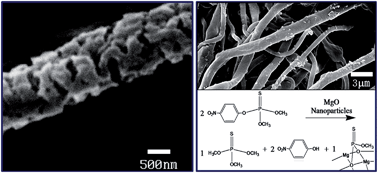MgO-embedded fibre-based substrate as an effective sorbent for toxic organophosphates
Abstract
Magnesium oxide nanoparticles (MgO) were embedded in a cellulose acetate fibrous framework to provide self-decontaminating properties against toxic organophosphates. The concept of a co-continuous polymer blend structure coupled with selective polymer dissolution was used to develop electrospun fibres with novel morphology for application in chemical protective materials. An electrospinning solution built from 60 : 40 acetonitrile–acetone and 15 wt% of 60 : 40 cellulose acetate–PEO distinct fractions produced fibres that had a degree of continuity of about 0.77 relative to the PEO phase in the cellulose acetate matrix that led to intra-fibre pores with an average diameter of 89 nm, and a surface area of 21.8 m2 g−1. MgO was incorporated into the spinning solution for development of a fibre framework with self-decontamination properties for toxic organophosphates. In 100 min, the MgO-embedded fibres removed 33% of methyl parathion from a hexane solution while fibres with similar morphology and no MgO removed 14%.


 Please wait while we load your content...
Please wait while we load your content...